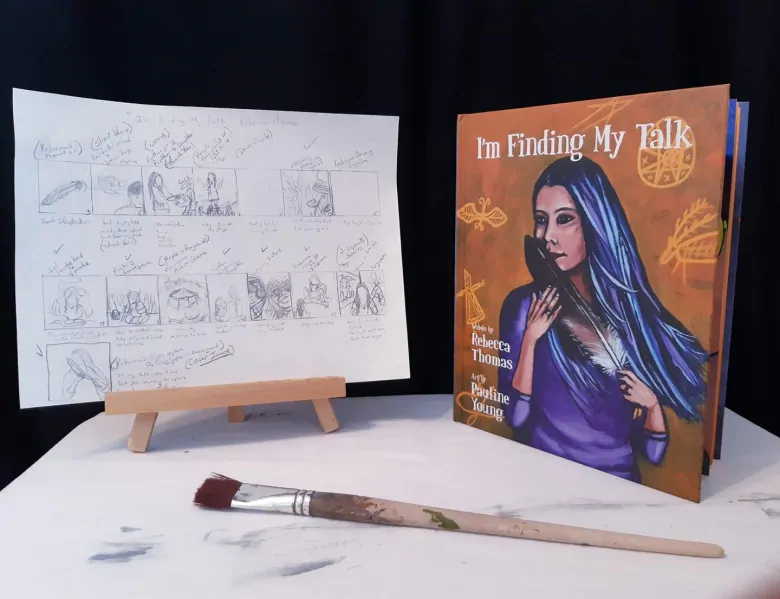Mi'kmaw artist draws on past abuse for first illustration project

When Mi’kmaw artist Pauline Young was commissioned to illustrate two picture books she didn’t hesitate to take on the project.
But she admits she didn’t know where to start.
Young worked for a year painting 29 pictures on 8×10 canvasses for the books I Lost My Talk by Rita Joe and the response to that book, I’m Finding My Talk by Rebecca Thomas.
Joe, a Mi’kmaw poet and songwriter, used her writing to express the loss of her native language at residential school in Shubenacadie, N.S.
“They gave me the poem and I read the poem and then they broke it down for me in sections,” Young said.
“The first, it says I lost my talk. I had to think of a way, every little verse, I had to put a picture in every little verse.”
Young, who lives in Whitney, N.B. but is a member of the Metepenagiag First Nation, said she didn’t have to think hard about the subject matter depicted in the two poems — residential schools and the Sixties Scoop.
“It was similar to my life.”
Life in foster care
Young and three of her siblings were taken from their Mi’kmaw mother and placed in a foster home. She says they suffered abuse.
They remained in foster care for close to four years before their mother was able to regain custody and take her family to Boston to rebuild their lives.
“When I paint I have to paint the feeling. I have to paint the feeling of I Lost My Talk. I have to go there — the talk you took away.”
Young said it was easy for her to go to a place where she could feel that because of what she experienced as a child. She was forced to spend long periods of time in a woodshed.
“For me to get to get the feeling of residential school and to portray Rita, I had to go there. I had to go back to that woodshed.”
Young said it was a difficult process but she said it also helped her.
“I’ve been telling people about my life but I don’t think anybody believed me so I just put it aside. You know, I put all the abuse aside. But then this came up for residential schools and through truth and reconciliation everyone needs to know this, right.”
“So, it’s getting really difficult to talk about this but I can talk a little bit.”
Joe describes in her poem about having her long hair cut by the nuns at the residential school. Young, too, had her hair cut off.
Being forced to stay outside on cold winter days has also affected Young. “I hate to be cold because I was cold in my childhood.”
‘They knew I could do it’
Having never illustrated before, Young had to learn how the stages of getting the pictures from her head to paper to the book. She said the publisher helped her with that.
“I had to research how to be an illustrator. But they knew I could do it.”

She drew thumbnail sketches, then turned those tiny sketches into drawings. Once everything was approved, she created the paintings.
“I would stay until three o’clock in the morning. When I have a project and I’m excited about it, I can’t sleep.”
Her excitement continued when she finally got to hold of the book for the first time.
“I love books and to hold those books in my hand, I cried.”
A clear plastic bin in Young’s studio holds the original paintings used to create the illustrations in the books. She took those to the book launch in Halifax in October and hung them up for people to see.
“I wanted everyone to see them.”
New project
Young said she is amazed at the response to the books as she prepares for a book signing in Miramichi, at the Newcastle Public Library, on Dec. 14.

She plans to do a series of empowerment pieces for women for her next project. “Showing women strong, standing tall, strong, doing positive things.”
For herself, she wants to do more and share her work with more people.
“I don’t want to be just a survivor,” she said. “I want to be a warrior.”





